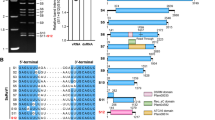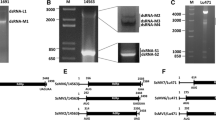Abstract
Sclerotinia sclerotiorum ourmiavirus 17 (SsOV17) was isolated from the hypovirulent strain GF3 of Sclerotinia sclerotiorum. The genome of SsOV17 is 2,802 nt in length and contains a single long open reading frame (ORF) flanked by a short structured 5ʹ-untranslated region (5ʹ-UTR) (28 nt) and a long 3ʹ-UTR (788 nt), respectively. The ORF encodes a protein with 663 amino acids and a predicted molecular mass of 75.0 kDa. A BLASTp search indicated that the protein encoded by SsOV17 is closely related to the putative RNA-dependent RNA polymerase (RdRp) of Sclerotinia sclerotiorum ourmiavirus 13 (71% identity). A multiple sequence alignment indicated that eight conserved amino acid motifs were present in the RdRp conserved region of SsOV17. Phylogenetic analysis demonstrated that SsOV17 clustered with members of the genus Botoulivirus.


Similar content being viewed by others

References
Ayllon MA, Turina M, Xie J, Nerva L, Marzano SL, Donaire L, Jiang D, Consortium IR (2020) ICTV virus taxonomy profile: Botourmiaviridae. J Gen Virol 101:454. https://doi.org/10.1099/jgv.0.001409
Bolton MD, Thomma BP, Nelson BD (2006) Sclerotinia sclerotiorum (Lib.) de Bary: biology and molecular traits of a cosmopolitan pathogen. Mol Plant Pathol 7:1–16. https://doi.org/10.1111/j.1364-3703.2005.00316.x
Chiapello M, Rodríguez-Romero J, Ayllón MA, Turina M (2020) Analysis of the virome associated to grapevine downy mildew lesions reveals new mycovirus lineages. Virus Evol. 6:veaa058. https://doi.org/10.1093/ve/veaa058
Farr DF, Rossman AY (2021) Fungal databases, U.S. National Fungus Collections, ARS, USDA. https://nt.ars-grin.gov/fungaldatabases/. Accessed 25 Mar 2021
Ghabrial SA, Caston JR, Jiang D, Nibert ML, Suzuki N (2015) 50-plus years of fungal viruses. Virology 479–480:356–368. https://doi.org/10.1016/j.virol.2015.02.034
Jia J, Fu Y, Jiang D, Mu F, Cheng J, Lin Y, Li B, Marzano S-YL, Xie J (2021) Interannual dynamics, diversity and evolution of the virome in Sclerotinia sclerotiorum from a single crop field. Virus Evol. https://doi.org/10.1093/ve/veab032
Kondo H, Kanematsu S, Suzuki N (2013) Viruses of the white root rot fungus, Rosellinia necatrix. Adv Virus Res 86:177–214. https://doi.org/10.1016/B978-0-12-394315-6.00007-6
Liu HQ, Fu YP, Jiang DH, Li GQ, Xie J, Peng YL, Yi XH, Ghabrial SA (2009) A novel mycovirus that is related to the human pathogen Hepatitis E Virus and Rubi-like viruses. J Virol 83:1981–1991. https://doi.org/10.1128/Jvi.01897-08
Liu L, Xie J, Cheng J, Fu Y, Li G, Yi X, Jiang D (2014) Fungal negative-stranded RNA virus that is related to bornaviruses and nyaviruses. Proc Natl Acad Sci USA 111:12205–12210. https://doi.org/10.1073/pnas.1401786111
Marzano S-YL, Nelson BD, Ajayi-Oyetunde O, Bradley CA, Hughes TJ, Hartman GL, Eastburn DM, Domier LL (2016) Identification of diverse mycoviruses through metatranscriptomics characterization of the viromes of five major fungal plant pathogens. J Virol 90:6846–6863. https://doi.org/10.1128/Jvi.00357-16
Mu F, Xie J, Cheng S, You MP, Barbetti MJ, Jia J, Wang Q, Cheng J, Fu Y, Chen T, Jiang D (2018) Virome characterization of a collection of Sclerotinia sclerotiorum from Australia. Front Microbiol 8:2540. https://doi.org/10.3389/fmicb.2017.02540
Potgieter AC, Page NA, Liebenberg J, Wright IM, Landt O, van Dijk AA (2009) Improved strategies for sequence-independent amplification and sequencing of viral double-stranded RNA genomes. J Gen Virol 90:1423–1432. https://doi.org/10.1099/vir.0.009381-0
Siddique AB (2020) Viruses of endophytic and pathogenic forest fungi. Virus Genes 56:407–416. https://doi.org/10.1007/s11262-020-01763-3
Turina M, Hillman BI, Izadpanah K, Rastgou M, Rosa C, Ictv Report C (2017) ICTV virus taxonomy profile: Ourmiavirus. J Gen Virol 98:129–130. https://doi.org/10.1099/jgv.0.000725
Wang Q, Mu F, Xie J, Cheng J, Fu Y, Jiang D (2020) A single ssRNA segment encoding RdRp is sufficient for replication, infection, and transmission of ourmia-like virus in fungi. Front Microbiol 11:379. https://doi.org/10.3389/fmicb.2020.00379
Wu M, Jin F, Zhang J, Yang L, Jiang D, Li G (2012) Characterization of a novel bipartite double-stranded RNA mycovirus conferring hypovirulence in the phytopathogenic fungus Botrytis porri. J Virol 86:6605–6619. https://doi.org/10.1128/JVI.00292-12
Xiao X, Cheng J, Tang J, Fu Y, Jiang D, Baker TS, Ghabrial SA, Xie J (2014) A novel partitivirus that confers hypovirulence on plant pathogenic fungi. J Virol 88:10120–10133. https://doi.org/10.1128/JVI.01036-14
Xie J, Jiang D (2014) New insights into mycoviruses and exploration for the biological control of crop fungal diseases. Annu Rev Phytopathol 52:45–68. https://doi.org/10.1146/annurev-phyto-102313-050222
Xu L, Li G, Jiang D, Chen W (2018) Sclerotinia sclerotiorum: an evaluation of virulence theories. Annu Rev Phytopathol 56:311–338. https://doi.org/10.1146/annurev-phyto-080417-050052
Yu X, Li B, Fu Y, Jiang D, Ghabrial SA, Li G, Peng Y, Xie J, Cheng J, Huang J, Yi X (2010) A geminivirus-related DNA mycovirus that confers hypovirulence to a plant pathogenic fungus. Proc Natl Acad Sci USA 107:8387–8392. https://doi.org/10.1073/pnas.0913535107
Acknowledgements
This research was financially supported by the National Key Research and Development Program of China (2017YFD0201100), the National Natural Science Foundation of China (31772111), and the Earmarked Fund for China Agriculture Research System (CARS-12).
Author information
Authors and Affiliations
Corresponding author
Ethics declarations
Conflict of interest
The authors declare that they have no conflict of interest.
Ethical approval
This research did not use human participants or other animals.
Additional information
Handling Editor: Massimo Turina.
Publisher's Note
Springer Nature remains neutral with regard to jurisdictional claims in published maps and institutional affiliations.
Supplementary Information
Below is the link to the electronic supplementary material.
Rights and permissions
About this article
Cite this article
Mu, F., Jia, J., Xue, Y. et al. Characterization of a novel botoulivirus isolated from the phytopathogenic fungus Sclerotinia sclerotiorum. Arch Virol 166, 2859–2863 (2021). https://doi.org/10.1007/s00705-021-05168-x
Received:
Accepted:
Published:
Issue Date:
DOI: https://doi.org/10.1007/s00705-021-05168-x



